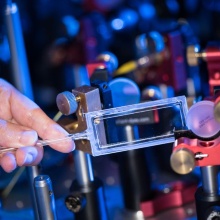The Top International Research Programme specifically promotes cooperations between research groups based in Baden-Württemberg and outstanding top international scientists. The proposal of IQST Fellows Tilman Pfau and Hans-Peter Buechler "Controlling atomic interactions and collective effects in thermal vapor cells" has recently been granted by the BW foundation and will be funded for 3 years. The joint research project will be carried out with guest researchers Charles Adams, JQC (Joint Quantum Center) @Durham University and Antoine Browaeys, Institute d'Optique, Paris who will join the groups of Tilman Pfau and Hans-Peter Buechler at the University of Stuttgart.
Abstract
Two- or few-level systems formed by real or artificial atoms with narrow-line resonances are often the basis for precision sensing (atomic clocks, magnetometry, electric field sensing) and quantum information processing. The readout via optical transitions is often favorable. In order to overcome the fundamental limits of readout shot-noise, it is desirable to use a large number of photons and atoms to extract the information with a high rate.
However, this combination of a high number density and a correspondingly high photon density leads to fundamental limits (e.g. line-shifts and -broadening) for any sensing application, due to the light-induced or vacuum-induced mutual interaction between the atoms. The spatial distribution of the atoms as well as the presence of tailored light guiding modes can enhance or suppress these light induced interactions. We chose to combine hot atomic vapors at variable densities with novel, nanostructured light-guiding elements. This promising system allows us to control the intensity distribution and polarization of the light as well as dimensionality and the spatial distribution of the interacting atoms.
Based on such nanophotonic atomic vapor cells we will address the following main research questions:
- How can nanophotonics contribute to control the cooperative response of an atomic ensemble for atom-based sensing applications?
- How can nanofabricated light guiding structures be used to control atomic interaction effects?
- How can nonlinear effects be enhanced towards the single photon level using tailored nanophotonic light guiding structures?
- How can topologically nontrivial structures help to enhance functionalities of atom-based devices?


